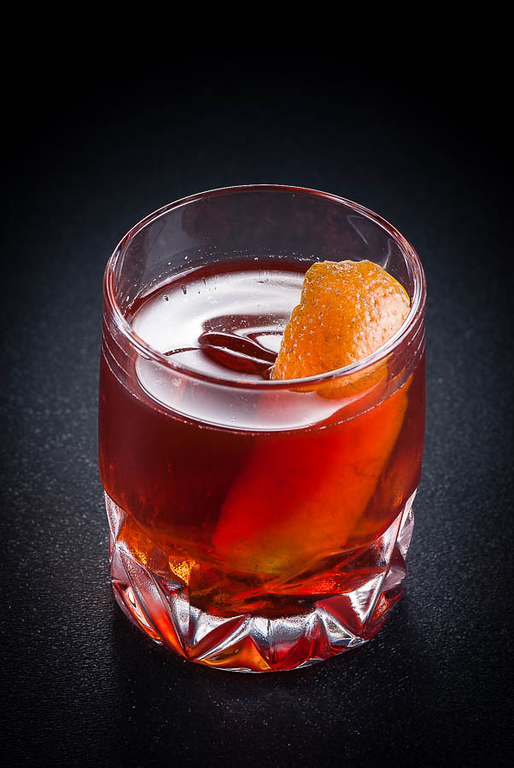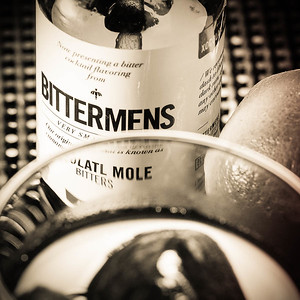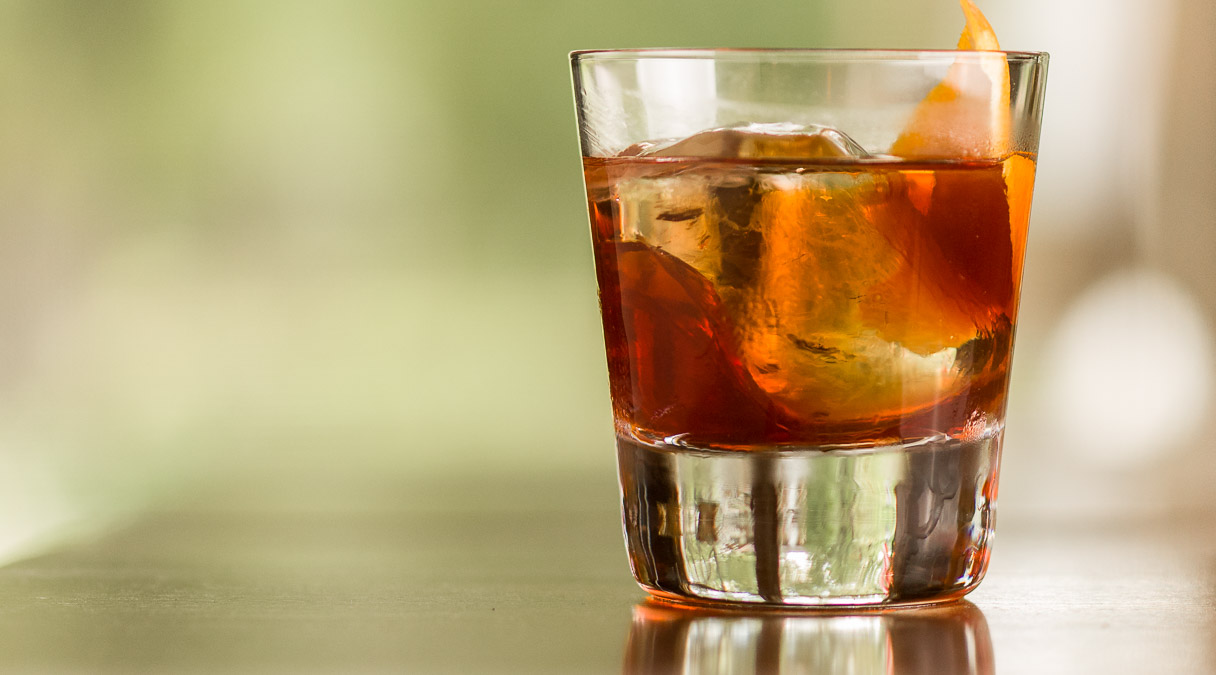The 1795 Cocktail is one of the Negroni’s modern descendants, from the whiskey-based Boulevardier side of the family.
More specifically, it’s a direct riff on the Boulevardier’s rye whiskey variant, Dominic Venegas’s 1794 Cocktail.
Two things make the 1795 special. For starters, it exploits American whiskey’s affinity for sweetness, and for dark, earthy flavors; the 1795 showcases that affinity without allowing any single ingredient—even the whiskey—to take over the drink completely.
The other interesting characteristic is that it’s a relatively low-alcohol cocktail—not a shim, exactly, but it has only a third to half the alcohol of a modern Manhattan or Martini, and it’s still able to retain a full, rich flavor.
I first learned of the 1795 from Frederic Yarm’s Cocktail Slut way back in 2010. As intriguing as it sounded, I never mixed one. The ingredient list was a bit of a stretch for me at the time—I was just getting acquainted with amaros like Campari and Aperol, and Carpano Antica and Bittermens bitters weren’t even available in my market at the time—so I filed the recipe away.
I suspect many others have looked at this ingredient list and done the same:
1795 Cocktail
Ted Gallagher, Craigie on Main, Boston, 2010
- 1–1½ oz rye whiskey (Rittenhouse)
- ½ oz Carpano Antica sweet vermouth
- ½ oz Punt e Mes
- ½ oz Campari
- ½ oz Aperol
- 1 dropper Bittermens Xocolatl Mole bitters
Stir all ingredients with ice until well chilled. Strain into an iced rocks glass. Flame orange peel over the glass, and add the peel as garnish.
(You see what I mean about the ingredient list. It’s not exactly home bar friendly, especially for someone just beginning to stock the shelves.)
The recipe surfaced again this summer (I clean my desk every few years, always with surprising results); to my delight, I found that my pantry had accreted all the required items over time. I also knew more about how that list of ingredients could work together.
It was time to give the 1795 a try.
I’m glad I did.

With so many moving parts in the 1795, I recommend a high-proof rye as the whiskey base. My old standby is Rittenhouse 100, and it works very well in this drink. Yarm’s original posting of the recipe reports that Gallagher experimented with Michter’s, which is rather soft for this mix; the extra backbone in the Rittenhouse works much better.
(The original listing called for 1 oz. of whiskey; if you aren’t committed to the “low alcohol” aspect of the drink, you can improve the mix by pushing the whiskey measure up to 1½ oz.)

The main strategy in the 1795 is to start with the 1794, a simple mix of rye whiskey, Campari, and sweet vermouth, and to mix with two amaros and two vermouths. When the Campari is combined with the slightly sweeter and softer Aperol, the mix brings faint, sweet notes of orange, of earthy rhubarb and gentian, and a touch of bitter quinine to the formula.
Gallagher specified two vermouths: Carpano Antica, with its prominent vanilla notes, and Punt e Mes, which combines fruity sweetness with quinine bitterness.
The Xocolatl Mole bitters add a fine, earthy note to the drink, and of course, the chocolate, orange, vanilla and whiskey are all natural flavor partners.
Drinking the 1795: The nose is, of course, smoky orange, with another faint fruit note I can’t identify, but that reminds me of cherries. The first taste is herbal and sweet, then a little bitter and earthy, and finally resolves into a sweet chocolate and whiskey tail.
Compared to its direct inspiration, the 1794, and to its more remote ancestor the Boulevardier, the 1795 is more complex and earthy and a bit softer on the palate. It also seems a bit sweeter.
Overall, once you’ve gathered the ingredients, the 1795 is easy to mix and a delight to drink. And one of these days I’ll set up a tasting flight, the Boulevardier, 1794, and 1795 side by side. That would make an interesting evening at the bar.
“Scions of the Boulevardier: the 1795 Cocktail” at cold-glass.com : All text and photos © 2014 Douglas M. Ford. All rights reserved.

Another fine entry
Perfect for the chilly nights that are laying in wait
Definitely an excellent Fall cocktail.
Starting at $75 for the Carpano – which She Who Must Be Obeyed drinks like it was M&R – this is a drink that will break my Fall liquor budget, for the drink. But, it looks so worth it. BTW, have you run across Bittered Sling bitters yet? They make a Malagasy Chocolate bitters that is amazing. 2 dashes in a G&T …
And I love your pictures!
$75, oof, you have tough prices in your region. I was not aware of the Malagasy bitters, that’s something I’ll have to watch for. I just saw the description on their web site, it sounds intriguing. Thanks for taking time to comment!
A third to half the alcohol content of a modern Manhattan? Where do you drink your Manhattans? (most Manhattans are 2 Oz whiskey to 1 Oz vermouth) even the “low alcohol” version is 1 Oz whiskey to 1 Oz vermouth and 1 Oz amaro. Clearly more than half (unless you meant percentage…)
I was thinking of the drinks served in the typical American bar—not the “craft” bars, but the ones most people have access to.
And your question goes right to the heart of one of the main reasons I don’t enjoy such places: the drinks are just too large. A Manhattan in such places is likely to be four ounces or so of 80-proof bourbon, a vanishingly small splash of vermouth, and a dash of Angostura (maybe). Same for the Martini.
Of course, if the same bartender that made that Manhattan made a 1795 instead, it might well be oversized, too… Alas!
Compared to that the modern cocktailian might make at home (or find in a first rate bar), the difference is certainly reduced—and I agree wholeheartedly with your sizing and proportions.
The drink size and ABV issues are important—thanks for raising the issue here.
Reblogged this on charityisrael's Blog and commented:
wow what a great cocktail
Thanks for all these thoughtful and delicious recipes; I have been enjoying them for months.
A practical question: what is the actual volume of a dropper, or a dash, or a “bar spoon”? I see some recipes that call for “6 drops of pepper tincture” but that seems hard to replicate. Or if I knew that 4 bar spoons = 3/4oz, that would be useful for mixing batches.
Also, is there more to flaming an orange peel than, well, holding it over a flame for a while?
Thanks!
I wish there were quick answers to bar measures questions, but there aren’t. Some of these measures are more practical than precise.
For example, that king of variability, the “dash.” Over the years, various writers of bar manuals have provided definitions, but each seems to be different from the rest. Estimates range from a sixth of a teaspoon up to an astonishing half-teaspoon. I’ve also seen it listed as “about 12 drops” (Frank Meier, The Artistry of Mixing Drinks.) It’s not a very easy amount to measure out, so for individual drinks, I usually just let a dash be whatever comes out of the dasher top on the bitters bottle, and for other things, like liqueurs, I put some in a little dasher bottle and dash away. You have to apply a little judgment with this technique, since even the “standard” dashers seem to deliver a different amount of liquid depending on how full the bottle is. Not a great answer, I know, and the weakest point in all these formulas. In the end, you have to get used to your dasher bottles, and adjust as you go along.
The “bar spoon” is another variable measure, but not quite as bad as the dash. According to David Wondrich (Imbibe!), the bar spoon has changed size over the years. He says it was once about a quarter-teaspoon, but is more like a sixth-teaspoon today. That said, my bar spoons seem to be a very standard style, and measure out to about an eighth of a teaspoon. I’d say that it’s reasonable to interpret a modern recipe’s “bar spoon” to be somewhere in that sixth- to quarter-teaspoon range.
I interpret “dropper” to refer to the dropper built into whatever bitters or tinctures bottles come with some of the bitters. I use a lot of Bittercube’s products, which are typically packaged in dropper bottles, and so I just use the dropper that comes with them. I also reuse those bottles if I make up my own tinctures; that makes for a pretty standard measure in my kitchen, and a good starting point, easily adjusted, if I’m trying someone else’s formulas.
As for flaming an orange—you’ll want a pretty fresh orange, one with plenty of oil and a firm skin. (My favorites are the ones my grocery sells as “juice oranges;” I have no idea what their proper name is, but they work spectacularly for flaming.) Cut a small piece of the orange skin, about the size of a quarter, avoiding the white pith as much as is practical. Hold a burning match near the rim of your glass, and the orange peel at the same level, a couple inches farther away. Lightly squeeze the orange peel so that the oils express through the flame toward the surface of the drink. Hilarity ensues.
I’m glad you’ve been enjoying Cold Glass, and I hope you continue to find it helpful—at least more helpful than that definition of “dash.”
I’m working on my own variation of the Boulevardier using Amari (my current obsession) — I call the drink the Colosseum, and the makeup of it is : 1.5 oz Bourbon (I’m using Eagle Rare 10), ¾ oz Meletti 1870 Bitter, ¾ oz Cynar, served with a lemon twist. I prefer it up, but you could also do it on the rocks. It might work even better with Rye, as it is a touch on the sweet side at this point. That’s my next thing to attempt. The Meletti is gentler than Campari, but the Cynar is of course quite a bit more demanding than any Vermouth, so those aspects seem to balance out quite well.
I bought the Mole Chocolate bitters years ago, thinking there might be a resemblance to Bittered Slings ‘Malagasy Chocolate’ bitters; not so much. I had no idea what to do with them, but some of these recipes, like the 1794 are perfect. Too bad I can’t drink them fast enough in this heat :-)
Excellent! I’m glad you’re finally able to put them to use. Thanks!